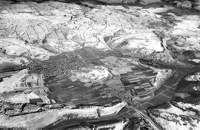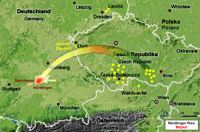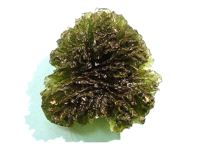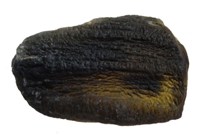Moldavite Info
Back to Moldavite
Moldavites are green, brownish-green or brown natural glasses (Mohs scale 5.5 - 6.6), in all probability formed by a meteorite (perhaps 1.5 km in diameter) impact in southern Germany (Bavaria).
Since decades people searched for moldavites and sold them. Today moldavites become harder and harder to find, and their price might increase.
Moldavite got its name from the main strewnfield (of a meteorite impact) in Bohemia, traversed by the river Vltava (German: Moldau).
Moldavites contain more or less 80% SiO2, 10% Al2O3, 3% K2O, 2% FeO, 2% MgO, 1.5% CaO, 0.5% Na2O3 and 0.5% TiO2.
Formation
 |
 |
| The Steinheim Crater |
About 2 seconds after the impact of the "Ries meteorite" masses of rocks (about 150 km3) were thrown out of the crater, covering an area up to 40 km away with the ejected stones, up to 100 m (near the crater).
 |
| The Steinheim Crater * |
 |
Thousands of years after the impact the crater (then still 100 m deep because 400 m were filled with melted rocks and impactites like suevite) was filled with water. One estimated that the huge suevite
 |
| The Ries Crater * |
Today the large circular depression (diameter: 24 km) is still visible, known as the "Nördlinger Ries", with the beautiful middle-age town Nördlingen near the center.
* Photo by kind permission of © www.rieskrater-museum.de, Dr. Schieber.
* Photo by kind permission of © Landesmedienzentrum Baden-Württemberg and Albrecht Brugger.
Resources
 |
The most famous deposits are in the first strewnfield near České Budějovice (German: Budweis): the sand pits near Ločenice and Vrábče, and the clay pit near Besednice. These moldavites are usually bottle-green and transparent.
Deposits in the second strewnfield near Brno (southern Moravia) contain darker, olive-green to brown moldavites.
Color and Quality
 |
| Fern-like Bohemian Moldavite * |
 |
| Brown Moravian Moldavite * |
The most sought-after moldavites for faceting are green in combination with a high transparency. The best of them show a special fern-like surface.
* Photo by kind permission of © http://skywalker.cochise.edu/wellerr/aawellerweb.htm, Roger Weller.
* Photo by kind permission of © http://www.moldavit.de, Th. Dehner.
Moravian Moldavites are usually much larger compared to Bohemian, but the color is usually on the brown side. Also they are much rarer compared to the Bohemian ones.
One can spend days walking the Moravian fields not finding a single one (average weight 11 g). On Bohemian fields one can find between 1 - 20+ a day (average weight 5 g).
Thanks to Ales Patrick Krivanek for his friendly support.
⇐ Intro Page ⇐ Gemstones ⇐ Moldavite